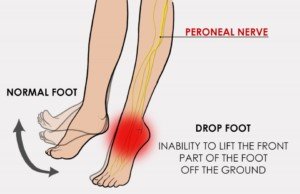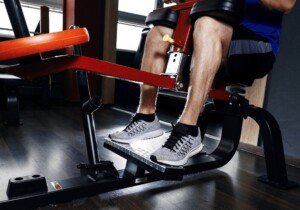
If twitching muscles have you panicking, here’s how to do foot drop strength tests.
If you’re terrified that the twitching muscles in your leg or foot might mean that you have ALS (and you would have gotten this idea after googling “twitching muscles,” no doubt), then invariably, you soon learned of a phenomenon called foot drop.
Foot drop itself is not a disease; it’s a symptom that can have many causes.
“Foot drop is typically neurological in nature,” says Dr. Bruce Pinker, DPM, who specializes in sports medicine and surgery of the foot and ankle.
In addition to a neurological cause, “It can be due to stroke (cerebral vascular accident – CVA), which may or may not resolve with physical therapy,” continues Dr. Pinker.
“Usually, in cases of foot drop, the forefoot drags on the floor — as the foot cannot clear the ground during the swing phase of gait.”
But how do you do strength tests for foot drop?
If you had this problem, for real, not just perceived, your gait would be altered to accommodate it.
Namely, you’d be having to lift your knee higher when walking.
Is that what you’ve been doing lately? If not, ask yourself why you’re convinced you have foot drop (other than googling “twitching muscles”).
Now let’s think of some everyday movements that foot drop would prevent you from doing.
Using the pedals of your car might come to mind. Think of how often, during just one 20-minute trip in your car, your foot must flex and extend to work the pedals.

Shutterstock/StepanPopov
There are muscles in the lower leg that move (flex and extend) the foot. If they are weak enough, the foot will drop.
If you have a disease causing enough foot drop to interfere with your walking, it will also interfere with using your car’s pedals.
What about actual strength tests?
The gas pedal usage is a test of flexion and extension with no resistance. But strength? Well, how about trotting up a flight of stairs?
That takes a lot more strength then using a gas or brake pedal.
Can you trot up a flight of stairs without stumbling or struggling?
If your ability to do this has not changed, then this should be reassuring.
Let’s take the foot drop strength test a bit further now. If you belong to a gym, load a calf raise machine with weights. Go up on your toes, then go down (extend, then flex).

Shutterstock/Denis Val
Though the calf raise equipment is designed to work the calves, the foot plays a key role in this because calf muscles move the feet!
For instance, your gastrocnemius and soleus muscles (major calf muscles) are responsible for plantarflexion (going up on the balls of your feet).
Your anterior tibialis muscle enables dorsiflexion (raising the foot/toes upward).
On the calf machine, these two joint actions are possible with weights. See what you can do.
Don’t try to break records; just do what you’ve either been doing, or if you’ve never used this machine, start with light weights.
After doing what you can (don’t overdo it, though; you don’t want sore calves), ask yourself how possible it is to have pathological foot drop if both feet can carry out the motion.
Another strength test is a hard sprint across a parking lot. To be able to do this you must have fully intact, fully functioning muscles and nerves.

Shutterstock/Franck Camhi
Do some jumping. Jump onto a boulder or bench. Leap across a puddle or up a few stairs.
Jump down from a few steps. Jump rope. Bunny hop. Do squat jumps. Kick a heavy bag.
“The activities you have mentioned would qualify as a self-test for whether or not one has foot drop,” says Dr. Pinker.
Unfair Strength Tests for Drop Foot
If you’re freaking out over twitching muscles and decide that a good strength test for drop foot would be to see how long you can balance on one leg, you will set yourself up for doom.
That’s because balancing on one leg, while in a state of fear, is not easy, even for a fit individual. Instead, just run down the street for your strength test.
Don’t try crazy things like seeing if you can hop up a flight of stairs on one leg.
Even a healthy fit person would find this very difficult. Don’t even try hopping across a room on the single leg.
These feats require a level of agility and strength that come from specific training.
The average person will struggle or may not even be able to do them.
And remember, exercise can cause some harmless muscle twitching.

 Dr. Pinker
Dr. Pinker









